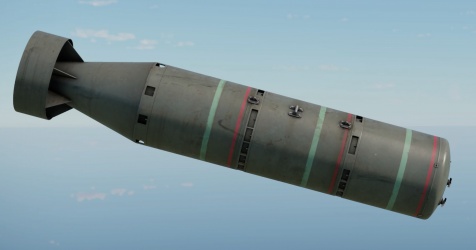H.C Mk.I (12,000 lb)
Contents
Description
During World War II the British military were employing the 4,000 lb H.C. Mk.II and 8,000 lb H.C. Mk.II bombs. Looking for larger options, engineers compared the explosive potential damage of dropping both an 8,000 lb and a 4,000 lb bomb versus a single 12,000 lb version and determined that the 12,000 lb bomb would provide a larger damage potential. Utilizing existing stock, a 4,000 lb bomb was bolted onto a 8,000 lb bomb and the detonation train was connected. Though approved for service, there was doubt with the Air Staff that the two bomb halves simultaneously detonated, so production of the bomb was limited. The 12,000 lb H.C. Mk.I bomb took aircraft maintenance crews 35 minutes to get the bomb loaded into the Lancaster from its transport trolley.
Vehicles equipped with this weapon
General info
| Bomb characteristics | |
|---|---|
| Mass | 12,656 lbs |
| Explosive mass | 3,973.5 kg |
| Explosive type | Torpex |
| TNT equivalent | 6,357.6 kg |
| HE max penetration | 365 mm |
| Armour destruction radius | 114 m |
| Fragment dispersion radius | 374 m |
Effective damage
With a huge destruction radius of 114 m, nothing that stands near an exploding 12,000 lb H.C Mk.I is likely to survive. Simply aiming the bomb near a capture zone will guarantee destruction of anything inside of it's destruction radius (this also applies to teammates so be careful!). The fragment dispersion is very effective even past 370 m thanks to almost 2 tons of steel surrounding the Torpex explosive filler, more than enough to kill lightly armoured vehicles such as SPGs and SPAA or at least damaging crew.
Comparison with analogues
The Soviet 5,000 kg FAB-5000 bomb is the closest comparable bomb to the British 12,000 lb H.C Mk.I "Blockbuster" bomb. The FAB-5000 carries ~1,000 kg TNTe less explosive mass and has a slightly smaller explosion radius compared to the Blockbuster.
Usage in battles
Describe situations when you would utilise this bomb in-game (vehicle, pillbox, base, etc)
Pros and cons
Pros:
- Extremely large destruction radius
Cons:
- Significantly hinders flight performance
- Carried by only one aircraft type
History
Examine the history of the creation and combat usage of the weapon in more detail than in the introduction. If the historical reference turns out to be too long, take it to a separate article, taking a link to the article about the weapon and adding a block "/History" (example: https://wiki.warthunder.com/(Weapon-name)/History) and add a link to it here using the main template. Be sure to reference text and sources by using <ref></ref>, as well as adding them at the end of the article with <references />.
Media
Excellent additions to the article would be video guides, screenshots from the game, and photos.
See also
Links to the articles on the War Thunder Wiki that you think will be useful for the reader, for example:
- reference to the article about the variant of the weapon;
- references to approximate analogues by other nations and research trees.
External links
Paste links to sources and external resources, such as:
- topic on the official game forum;
- other literature.




